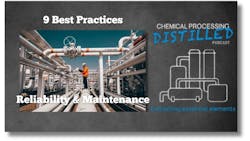Podcast: 9 Best Practices for Reliability and Maintenance
This episode from Chemical Processing's Distilled podcast shares industry best practices for chemical plant reliability and maintenance. Key recommendations include understanding equipment failure modes through predictive maintenance techniques like vibration analysis and thermography, developing balanced preventive maintenance programs that avoid over-maintaining equipment, and conducting thorough root cause analysis using methods such as 5-why analysis and fishbone diagrams.
Transcript
Welcome to Chemical Processing’s Distilled Podcast -- I’m Traci Purdum, EIC of Chemical Processing.
Please subscribe to this free podcast on your favorite platform.
In this episode I’ve scoured content from Chemical Processing to bring you 9 best practices for reliability and maintenance.
Our articles and columns are packed with great tips and this is a curated list of advice that has been shared over the years.
1. Equipment Reliability
Understanding failure modes is crucial. Study historical data to identify common failure patterns in pumps, heat exchangers, reactors, and other critical equipment. Implement predictive maintenance using vibration analysis, thermography and oil analysis to catch issues before they lead to failures.
2. Preventive Maintenance Programs
Develop comprehensive preventive maintenance schedules based on manufacturer recommendations and operational experience. Don't over-maintain — excessive maintenance can introduce new failure modes. Focus resources on critical equipment that impacts safety, production or environmental compliance.
3. Root Cause Analysis
When failures occur, dig deep to find true root causes rather than just addressing symptoms. Use techniques like:
5-why analysis, which is a problem-solving technique that helps identify the root cause of an issue by repeatedly asking "why" five times. By digging deeper into the contributing factors with each successive "why," the method helps move from surface symptoms to the underlying cause. The goal is to understand the core reason for a problem, rather than just addressing the surface-level manifestations.
You can also implement fishbone diagrams, which are visual tools used for root cause analysis to identify the many possible causes of a specific problem or event. It helps in brainstorming and organizing potential causes into categories, providing a structured approach to problem-solving.
Another way is to use Fault Tree Analysis (FTA), a top-down, graphical method for analyzing the potential causes of system failures. FTA visually represents the logical relationships between events that can lead to an undesired outcome, such as a system failure. By starting with the top event (the undesired outcome) and breaking it down into its contributing factors, FTA helps identify the root causes of failures and assess the probability of occurrence.
Whatever method used, Document findings and share lessons learned across your organization.
4. Materials and Corrosion Management
Select appropriate materials of construction for your process conditions. Monitor corrosion rates through inspection programs and corrosion coupons. Corrosion coupons are small metal samples, typically strips or discs, used to monitor and assess corrosion rates in various systems like water treatment and oil & gas pipelines. They are pre-weighed and then placed in the system to be monitored, exposed to the corrosive environment for a set period. After the exposure, they are removed, cleaned and reweighed to determine the amount of material lost due to corrosion. This weight loss is then used to calculate the corrosion rate, often expressed in mils per year.
Also consider protective coatings, cathodic protection, which is a technique used to prevent or minimize corrosion of metallic structures by making them the cathode in an electrochemical cell. It works by applying a negative charge to the metal, which inhibits the electrochemical reactions that cause corrosion. Another practice is chemical inhibitors --substances that reduce or prevent chemical reactions from occurring. They can be used to slow down or halt chemical processes, protect materials from corrosion, or inhibit the activity of enzymes.
5. Process Monitoring and Control
Maintain proper process conditions to minimize equipment stress. Monitor key parameters like temperature, pressure, flow rates, and chemical compositions. Unexpected process upsets often accelerate equipment degradation.
6. Spare Parts Strategy
Maintain critical spares inventory based on lead times and failure probabilities. Consider standardizing equipment across units to reduce spare parts variety. Establish relationships with reliable suppliers for quick delivery of non-stocked items.
7. Documentation and Data Management
Keep detailed maintenance records and equipment histories. Use computerized maintenance management systems (CMMS) effectively. Track key performance indicators like mean time between failures (MTBF) and overall equipment effectiveness (OEE).
8. Safety Integration
Always prioritize safety in maintenance activities. Ensure proper lockout/tagout procedures, confined space protocols and hot work permits. Remember that poorly maintained equipment poses significant safety risks.
9. Continuous Improvement
Regularly review maintenance strategies and adjust based on performance data. Benchmark against industry best practices. Engage operators and maintenance technicians — they often have valuable insights about equipment behavior.
Thank you for listening to Chemical Processing’s Distilled podcast. Subscribe to this free podcast so you can stay on top of best practices – you can also visit us at chemicalprocessing.com for more tools and resources aimed at helping you achieve success.
About the Author
Traci Purdum
Editor-in-Chief
Traci Purdum, an award-winning business journalist with extensive experience covering manufacturing and management issues, is a graduate of the Kent State University School of Journalism and Mass Communication, Kent, Ohio, and an alumnus of the Wharton Seminar for Business Journalists, Wharton School of Business, University of Pennsylvania, Philadelphia.

